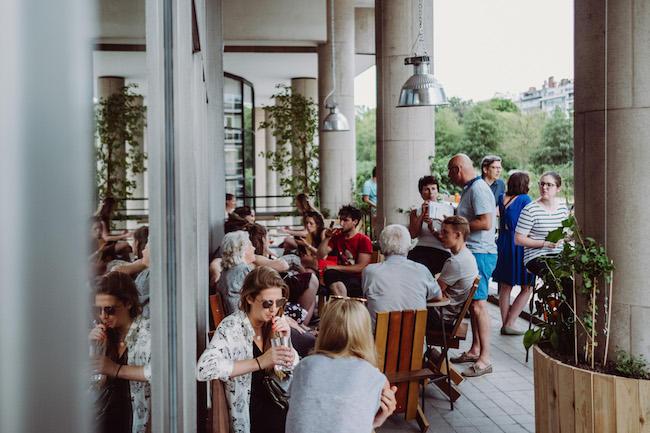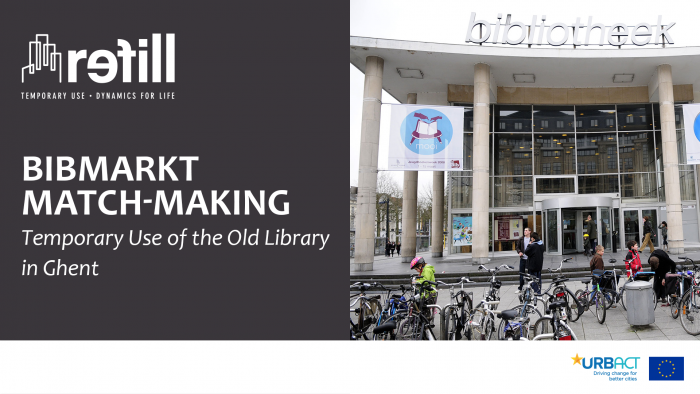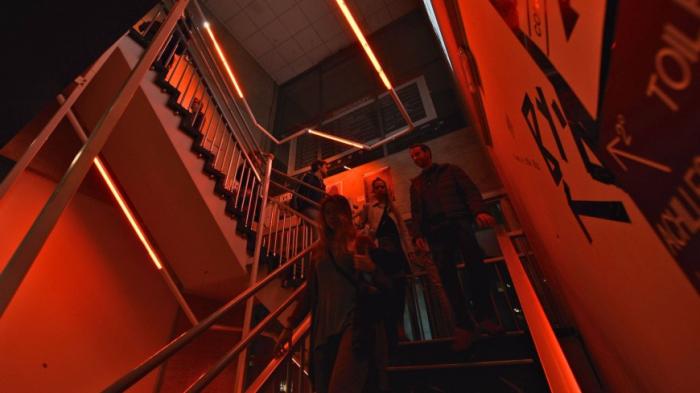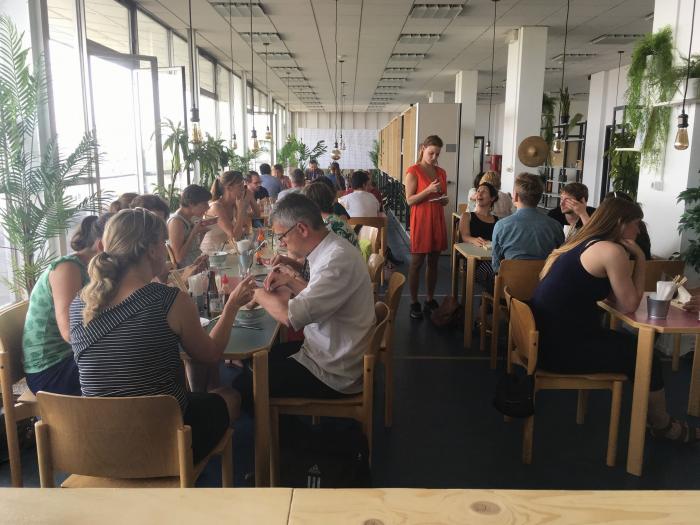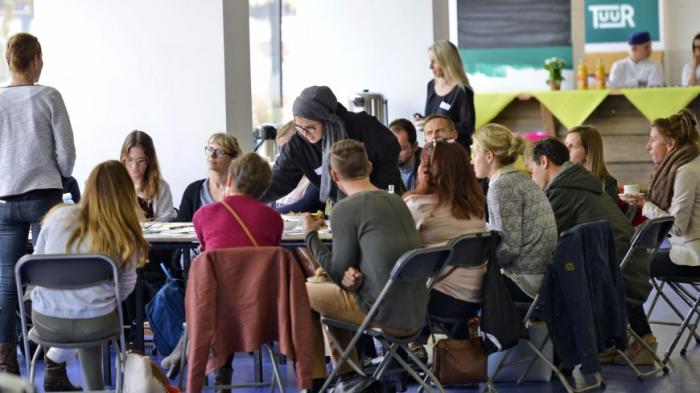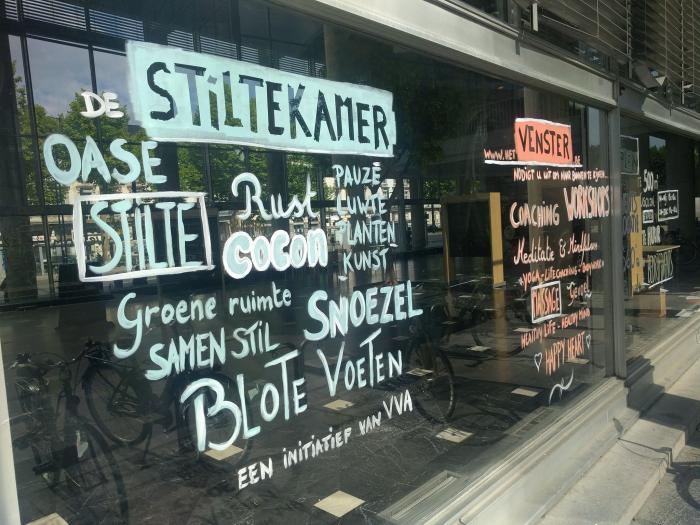I. SUMMARY INFORMATION
Project
268592
Status
Submitted
Award category
Reinvented places to meet and share
You want to submit
NEW EUROPEAN BAUHAUS AWARDS : existing completed examples
Project title
NEST
Full project title
New sustainable use of temporary vacant spaces in Ghent
Description
Having moved its main municipal library to a new location, the City of Ghent was looking for a temporary purpose for the old library building. NEST is a temporary living lab for the city of the future where engaged residents can connect to smart networks. It hosts a café, a co-working space, a quiet space, a restaurant, music, theatre, movement, debate, reading and large events. Experimentation with cooperative management, sustainability and a democratic decision model were of crucial importance
Where was your project implemented in the EU?
Belgium
Flanders
Woodrow Wilsonplein 1
Ghent
9000
When was your project implemented?
Has your project benefited from EU programmes or funds?
Yes
Which programme(s) or fund(s)? Provide the name of the programme(s)/fund(s), the strand/action line as relevant and the year.
REFILL was funded by URBACT III - call for action planning networks. It started in 2o15 and ended in 2018.
The project NEST - subject for the NEB application was financed by the cityhall Ghent. The matchmaking event to find a suitable coordinatior for NEST was financied by Urbact, as well as some communication.
II. DESCRIPTION OF THE PROJECT
Please provide a summary of your project
The City of Ghent has been experimenting with temporary use of brownfield sites and empty
buildings for over a decade. Often, this happens in response to urban renewal projects. With urban renewal, the period between the development and implementation of the plans is usually very long. This counters neglect, brings a new dynamic to neighbourhoods and offers added value for the city's development, the sites and buildings.
THE SITE (DE SITE), THE FIRST ICONIC PROJECT
10 years ago, allotments, a greenhouse, two urban horticultural plots, a football field, a bike
playground and an urban farmstead with 8 chickens were created on the site of the former Alcatel Bel factory in the social deprived district of Rabot (19the century belt). The residents, a divers mixed group, rolled up their sleeves and helped to reshape their neighbourhood.
AND MANY OTHERS followed….such as NEST (2017-2018)
Having moved its main municipal library to a new location, the City of Ghent and the departments involved were looking for a temporary purpose for the old library building. Due to the central location in the city and the purpose of the building, preference was given to a single coordinator for the project who was willing to accommodate multiple initiatives in one large (6 floors, 7,000 m²) building and connect several types of activities. The temporary use of the library had to be a beacon of creativity, social innovation, an economic incubator and an employment opportunity. The multidisciplinary jury of the Temporary Use Fund selected a suitable grassroot candidate - NEST. NEST stands out because of its unique collaboration model in which social and commercial projects strengthen each other. NEST is a temporary living lab for the city of the future where engaged residents connect to smart networks. It hosts a cafe, coworking space, quit space, restaurant, music, theatre, debate and large events. Experimentation with cooperative management and a democratic decision model were crucial.
Please give information about the key objectives of your project in terms of sustainability and how these have been met
Today, there is a lot of pressure on space in Ghent, so we must look for smart solutions for using space in the city. Temporary use of empty buildings and brownfield sites is an opportunity to create space for social, cultural and economic activities, and for creative, sustainability and innovative ideas. Temporary use of empty buildings and brownfield sites is an opportunity to create space for social, cultural and economic activities, and for creative, sustainability and innovative ideas. Re-using existing resources and constructions improves the awareness that urban space is a powerful and therefore precious resource. Equally, reusing vacant plots in the city with the involvement and commitment of administration, local inhabitants and stakeholders would allow an economic growth without requiring new construction and therefore be respectful of the surrounding environment. In addition, the reassessment of vacant space in the urban fabric results in proximity of various activity (economic, cultural, social, care,...),which creates conditions of urban densification, integration of working and living area, increases the efficiency of public transports and walking lifestyles towards a less polluting mobility. Furthermore, beyond experimental entrepreneurship vacant space is often shared with other bottom-up initiatives. .NEST offered multiple small-scale solutions (e.g. a sharing shop, culture participation, solidarity initiatives) and directly impacted the many societal challenges (youth, poverty, integration, etc.) that we are faced within cities.NEST created a co-working office and a co-creative space for their experimentation. In that way the concept of Temporary use boosted economic and social rehabilitation, innovation in the local community and at the same time given the neighbourhood a better image.These initiatives in the context of temporary use stimulate the development of multiple forms of sharing economy in which citizens are stimulated to re-use resources
Please give information about the key objectives of your project in terms of aesthetics and quality of experience beyond functionality and how these have been met
The entire EGW building (designed in 1956 by architect Geo Bontick) was in need of a thorough make-over so as to turn the former library (1992) into a futureproof workplace (2020 – 2023) for the staff of the City of Ghent. The old municipal library is a well-known landmark and is being restored to its former glory. The local authorities have opted for renovation instead of demolition. The renovation is part of an overall regeneration of the Zuid neighbourhood in the city centre. The former library is connected to the City’s Administrative Centre, while the adjacent municipal park is made more accessible, both visually and physically. The new building complex is being upgraded from an architectural perspective with more green spaces and a focus on soft mobility (Ghent is the most bicycle-friendly city in Belgium). In the renovation, particular attention is paid to preserving the building’s valuable historical character. Authentic heritage elements such as the parquet floor and panelling in the Mussche hall, the star-spangled ceiling and the glazed tiles have been preserved and restored. By opening NEST and the huge building to the public and making it easily accessible, with long opening hours and an open-door policy, a great deal of social and societal problems taking place on the square, in the immediate surroundings and at the traffic intersection have also become clear and have been made visible by NEST. The precarious situation of loitering teens, gangs and homeless people who sheltered in the building created tensions with local residents and forced the City to intervene, for instance by employing a social worker for young people, by developing a structural solution and by creating a space for young people. Social and urban revitalisating goes hand in hand.
Please give information about the key objectives of your project in terms of inclusion and how these have been met
We have seen a significant increase in new forms of solidarity and engagement in the city aimed at coming up with solutions to complex societal challenges of a social, spatial, economic and ecological nature. NEST, a pioneer and grassroots initiative stimulated the transition in our city and co-created solutions for societal challenges in this urban context, which is often seen as a laboratory.
NEST, a temporary use has thus created the right environment for the development of social innovation. (f.e. (repair-shop, cultural participation, sharing-activity, solidarity initiatives, social entrepreneurship, sheltering,...). The small scale solutions offered by temporary use projects mostly depend on the commitment of citizens, the community, etc. The way it is organised, is social and inclusive in itself.
New entrepreneurs and start-ups involved in NEST created job opportunities for several citizens, including employees with a lower degree or with other skills than the traditional job profiles in the centre of the city.
Please give information on the results/impacts achieved by your project in relation to the category you apply for
NEST became a household name in Ghent and offered a new experience every day. It provided numerous initiatives with the opportunity to start up a first or new activity for which they would not have been allocated spaces elsewhere in the city. Numerous initiatives benefited from NEST as an accessible and low-threshold experimentation method for trying out new ideas / concepts.
The initiatives within the scope of NEST made the following experiences possible:
⦁ exceptional collaboration with other entrepreneurs and initiatives
⦁ expanding the network and getting to know the community
⦁ a testing ground for the cooperation model
⦁ cross-pollination
⦁ increasing the visibility of a project
⦁ gaining new experiences and introduction to a new audience
⦁ taking the first steps in the professionalisation of a hobby
The added value for society created by 1 year of NEST has made it worthwhile, namely:
⦁ The City of Ghent dared to give an innovative purpose to an iconic building in the city centre
⦁ The City of Ghent dared to integrate this into a commons model and view it as an experiment for future evaluation
⦁ The willingness to experiment without being deterred by failure; NEST has opened doors and broadened the horizons
⦁ As a whole, NEST was a successful example of an experiment for many other cities, in terms of self-management, temporary use, cooperative entrepreneurship and collective management of public real estate
General benefits of NEST: existing infrastructure is reused,It brings new life to the city, It prevents vandalism, illegal squatting and other forms of nuisance, Buildings are maintained, it is a matchmaker between the policy ambitions of the city-hall, stakeholders and the citizens, It is a catalyst for social, sustainable, cultural and economic activities.
Please explain the way citizens benefiting from or affected by the project and civil society have been involved in the project and what has been the impact of this involvement on the project
NEST as an experiment for creativity, cooperative and democratic management and a decision model :The City launched a call for tenders with 273 initiatives and/or individuals registering for a site visit and a speed date, which provided creative people with the opportunity to meet each other and jointly submit a proposal that met the criteria set by the city. The jury opted for a collective called NEST (a limited-liability cooperative partnership established on the occasion of the call) and it received the keys to the library building on 1 May 2017. The jury was convinced by the concept, management model and layout that had been devised by the new collective. The City only provides space and technical support in the building. The collective was responsible for creating a new community-building function with the biggest possible mix of activities as well as for providing an accessible public space where everyone is welcome.The temporary initiative’s diverse range of activities was organised around thirteen “typologies”, including a fair for exchanging ideas, a one-stop-shop for all sorts of advice and coaching, a studio for recording sound and music, a workshop for designers and makers, a sharing point, a stage, a café, a restaurant, etc. This range of activities was made possible by more than thirty initiatives that were responsible for providing the activities in their space and for attracting ad-hoc users who would rent a space for a one-off event. As a result, a large variety of users and visitors could integrate their own activities into the existing offer. During the conception of the typologies, a strong focus was placed on “shared space”, on complementary and on interesting forms of cooperation. For each one of the thirteen typologies, there were points of contact ensuring the everyday management, organisation and communication in general. Preference was given to experiments of cooperative entrepreneurship and self-management resulted.
Please highlight the innovative character of the project
The NEST initiative appreciated the courage shown by the City of Ghent in giving an innovative purpose to an iconic building in the city centre. The City of Ghent also dared to integrate this into a commons or cooperative entrepreneurship model and view it as an experiment for future evaluation.
NEST differed from other temporary use projects in Ghent by 2 elements:
⦁ most importantly, the scale: the 7000 m² attracted a multitude of creative people who worked together and experimented with a very democratic form of organisation. The community of creative people in NEST grew every day and consolidated itself, spawning numerous creative initiatives in Ghent to date.
⦁ its central location in the city: compared to other temporary projects that were started up earlier on in the periphery, NEST was an experiment in cooperative entrepreneurship . the collective consisting of different initiatives and young entrepreneurs had to come up with a business model capable of organising the activities as well as collectively managing the huge building that had been put at its disposal and paying rent to the city.
NEST is yet another example of the city’s policy with regard to temporary use which has now become mainstream, made possible thanks to the innovative temporary use fund and the neighbourhood managers and bridges;
This Temporary Use Fund helps new initiatives to get started.Every year, the city council makes a budget of €300,000 available for this purpose. Information about the terms and conditions, and application procedure, can be found on http://stad.gent. Since the outset of the Temporary Use Fund, there has been an increase in smaller, bottom-up temporary use projects in the neighbourhoods of Ghent, supported and coordinated by citizens
Each of the 25 districts in Ghent has a neighbourhood manager.They play a key role by searching in the districts for citizens initiatives and opportunities (NEST).
Please explain how the project led to results or learnings which could be transferred to other interested parties
Partly thanks to the EU project “Refill”, the City of Ghent was able to a) document and b) upgrade & scale up its experimental policy as well as c) develop & share expertise, d) raise awareness and e) turn it into regular policy (it is an integral part of Ghent’s social and long-term urban development and policy participation) together with 8 other cities. Refill has drawn up a manual (A journey through Temporary Use) for other cities with tips, a framework and guidelines for starting up temporary use projects elsewhere, which is available on the blog. The temporary collective NEST is no longer active. However, the experience acquired has been developed further in different initiatives. A few creative people have continue to expand and have been allocated a permanent space in urban real estate, spread across the city centre, such as an arty and creative little shop in a busy shopping street. A large mansion has been made available as a silent area and for providing support and assistance to people with autism. The experience acquired from the meeting space / café has been continued in a café / restaurant in the city centre. Other initiatives have been able to convert their knowledge and experience into new activities and initiatives. For instance, BULB with its co-working space is now temporarily located in a building in the Muide neighbourhood, and once again it provides space to creative people and entrepreneurs, but now on the outskirts of the city. The partners NUcleo and Timelab have built up a great deal of knowhow about the management model and the experiments with cooperative working. The City of Ghent has also learnt a great deal about the collective management of real estate as well as the support of commons and citizen initiatives. The lessons learned have been included into the new projects regarding collective management, such as a longer-term use of the (deconsecrated) churches by and for local initiatives. The experiences are shared publicaly
Is an evaluation report or any relevant independent evaluation source available?
III. UPLOAD PICTURES
IV. VALIDATION
By ticking this box, you declare that all the information provided in this form is factually correct, that the proposed project has not been proposed for the Awards more than once under the same category and that it has not been subject to any type of investigation, which could lead to a financial correction because of irregularities or fraud.
Yes
